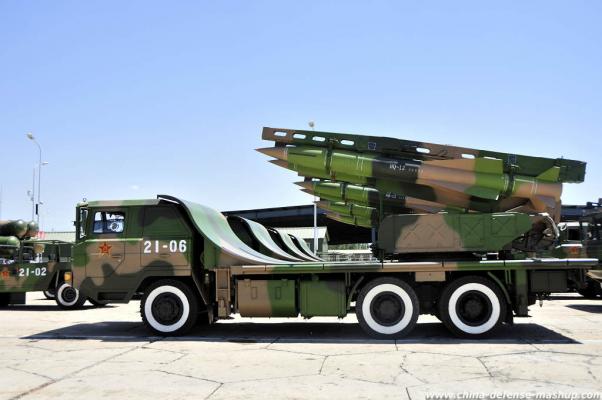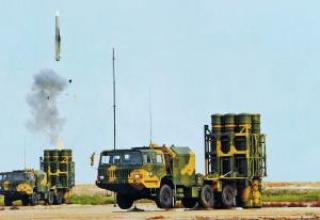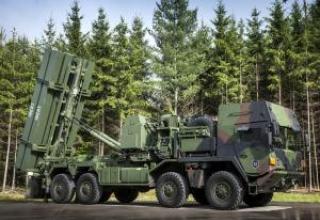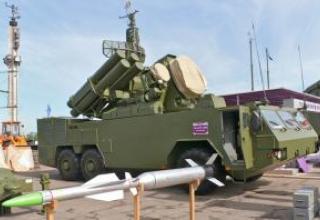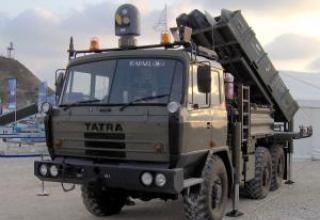The HQ-12 medium-range anti-aircraft missile system (HongQi-12, Khuntsi-12, Red Banner-12, export designation - KS-1A) is designed to engage enemy aircraft and helicopters at all altitudes of their combat application, day and night in any weather conditions.
The HQ-12 is designed by the Chinese company Jiangnan Space Industry, also known as Base 061. The development of a prototype of the complex began in the early 80's, as a replacement for the outdated SAM system HQ-2 (a Chinese copy of the Soviet S-75). Transported version of the complex under the designation of KS-1 was tested in 1989 and was first demonstrated at the Paris Air Show in 1991. The development of the KS-1 was completed in 1994, but its mass production was not launched due to serious shortcomings and lack of orders from PLA and foreign customers.
The development of an improved version under the designation KS-1A started in the second half of the 90s. The main difference between KS-1A and KS-1 is a mobile launcher on a cross-country vehicle chassis, as well as a new multifunctional radar station H-200 as part of the complex. Since 2001, China Precision Machinery Import-Export Corporation (CPMIEC) has been offering the KS-1A system on the world arms market. In 2005, officials of the Ministry of Defense of Malaysia announced a decision in principle to purchase the KS-1A by 2014.
Failures during testing of the new KS-1A system slowed down its adoption for service. In July-August 2007, when China celebrated the 80th anniversary of the PLA, the new SAM system as part of a mobile launcher and the H-200 radar was publicly exhibited at the Chinese Military Museum of Revolution, under the designation HQ-12, indicating its possible adoption by the PLA. Several HQ-12 batteries participated in the military parade dedicated to the 60th anniversary of China in 2009.
As of 2018, the complex was in service with the armies of Myanmar (KS-1A), Turkmenistan (KS-1A) and Thailand (KS-1C). HQ-12 complex was further developed by HQ-22 SAM system.
Composition:
The HQ-12 SAMs are included:
- anti-aircraft guided missiles (SAMs) (see photo);
- launchers (see photo1, photo2, photo3);
- H-200 multifunction illumination and pointing radar;
- means of technical operation (transport and charging machines, etc.) (see Photo 1, Photo 2).
Single-stage LSD HQ-12 (see diagram) is made according to the normal aerodynamic scheme. The casing of the rocket cylindrical in diameter 400 mm, equipped with four wings, in the tail of the body are four aerodynamic rudders. The length of the rocket - 5.6m, the starting weight of 886kg. The missile's marching engine is a two-mode solid fuel. The missile's shrapnel-type combat unit weighs 100 kg and is equipped with a radio detonator. Maximum flight speed of the rocket - 1200m / s, located overload 20g. Control system - radio command. The missile is designed primarily to defeat aircraft and helicopters and has limited combat capabilities against modern high-precision means of attack class "air-ground" and UAV.
Launch of the missile is inclined, with the launcher facing the corner of the place and azimuth. The transported four-supported KS-1 missile launcher is a modified version of the HQ-2 SAM system and has two rails. The modernized mobile PU of KS-1A complex is placed on the cross-country vehicle chassis with the wheel arrangement 6x6. PU KS-1A also has two guideways of rail type with lower missile suspension (see photo1, photo2, photo3). When deployed in combat position, the PU is mounted on hydraulic supports. Images of the KS-1A version with box-type launch containers (see photo) were published, protecting the missiles from external influences and facilitating maintenance and charging.
Target tracking and guidance station SJ-202 of KS-1 complex is a three-axis radar, which allows you to simultaneously accompany six targets and point at three of them 6 SAMs. It was reported that the station is most likely to operate in the G-band. The radar antenna is transported on a trailer. The SJ-202 radar can paired with the HQ-2 complex.
The improved version of the KS-1A air defense system differs from its prototype by the use of a new illumination and pointing radar H-200 instead of SJ-202. Multifunctional radar illumination and pointing H-200 consists of an antenna station, placed on a four-axle trailer (see photo), and a hardware container on the chassis of Taian TA5150A cross-country vehicle with the wheel arrangement 6x6 (see photo). Later, there were versions of this radar, placed on two Taian TA5270A (6x6) trucks. The antenna device of the H-200 radar is a phased antenna array of circular rotation with digital control of the beam position, which is similar in size to that of the HT-233 radar of the HQ-9 complex. The instrumental range of target detection is 115km, escort is 80km. H-200 provides simultaneous targeting of six missiles at three targets. According to the developers, the H-200 radar implements advanced data processing methods that provide effective target selection and protection against electronic suppression means. The station is equipped with a system of identification of "one's own", an autonomous power supply source and radio communications.
The typical battery of the complex includes radars for missile detection and guidance, four launchers with 8 SAMs and 18 missiles in ammunition. Some sources of the battery can be assigned to the HQ-9 Type-120 low-flying target detection radar.
Characteristics:
| Range of fire, km: - minimum - maximum at target speed up to 720m/sec - maximum at target speed up to 420m/sec - maximum at target speed up to 320m/sec |
7 ( 5 for KS-1A ) 38 42 50 |
| The height of the flight of the targets, m: - minimum - maximum |
500 25000 |
| Dimensions, mm: - length - diameter - wingspan |
5644 400 1200 |
| Maximum flight speed, m/s | 1200 |
| Starter weight, kg | 900 |
| Weight of combat unit, kg | 100 |
| Defeat radius BC, m | 50 |
| Available overload, g | 20 |
| Maximum overload of movement of affected targets, g | 4-5 |
| Maximum target speed, m/s | 750 |
| Deployment time, min | 30 |
| Conditions of combat use: - altitude at sea level, m - ambient temperature - relative humidity - surface wind speed |
0-3000 between -40 and +50°C <93% <20 m/sec |
Testing:
As of 01.01.1950, the factory batch of 230 shells was completed and sent to the Pavlograd test site.
In November 1949, pre-factory tests of 34 shells were carried out together with the fuse B-377 during which cases of missiles were revealed.
Special tests carried out to determine the causes of deficits showed that the most probable cause was an increased release of unburned reactive charge particles at the end of the active section of the trajectory.
In order to eliminate this phenomenon, in December 1949 a bench-top refinement of the engine was started with regard to aperture enhancement and ensuring that the powder charge was fixed in the chamber. After the end of the bench work and experimental firing for checking the reinforced aperture, the factory batch of projectiles was to be equipped with modified apertures on site and presented for factory tests in February 1950.
Sources:
- HongQi 12 (HQ-12, KaiShan 1, KS-1) Surface-to-Air Missile System /www.sinoDefence.com/
- PLA Area Defence Missile Systems /www.ausairpower.net/
- HQ-9 and HQ-12 SAM System Battery Radars /www.ausairpower.net/
- www.china-defense-mashup.com
